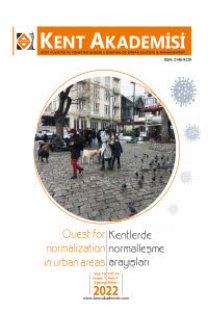Trafik Akışının Yollardaki Fotovoltaik Paneller ile Elektrik Üretimine Etkisi
Güneş Enerjisi, Fotovoltaik Paneller, Trafik Akışı, Yenilenebilir Enerji, Ulaşım
Effect of Traffic Flow on Electricity Generation with Photovoltaic Panels on Roads
Solar Energy, Photovoltaic Panels, Traffic Flow, Renewable Energy, Transportation,
___
- Alawaji, S. H. (2001). Evaluation of solar energy research and its applications in Saudi Arabia — 20 years of experience. Renewable and Sustainable Energy Reviews, 5 (2001), 59–77.
- Bedeloglu A., Demir B. & Bozkurt Y. (2010). Fotovoltaik Teknolojisi: Türkiye ve Dünyadaki Durumu, Genel Uygulama Alanları ve Fotovoltaik Tekstiller. Tekstil Teknolojileri Elektronik Dergisi 2010, 4(2), 43-58.
- Büyükkılıç, M. (2009). Güneş Enerjili Sistemlerin Yol Aydınlatması Amaçlı Kullanımı. [Yayımlanmamış yüksek lisans tezi]. İstanbul Teknik Üniversitesi Enerji Enstitüsü.
- Channi, H. K. (2019). Solar Pavement: Smart Means of Transportation. International Journal of Management, IT & Engineering, 9(2), 211-217.
- Çanka Kılıç, F. (2015). Güneş Enerjisi, Türkiye’deki Son Durumu ve Üretim Teknolojileri. Mühendis ve Makina, 56 (671), 4-28.
- Çelebi̇, G. (2013). Bina Düşey Kabuğunda Fotovoltaik Panellerin Kullanım İlkeleri. Gazi Üniversitesi Mühendislik Mimarlık Fakültesi Dergisi, 17 (3), 17-33.
- Dhoke, M., Naidu, H. & Ghutke, P. (2017). An Innovative Method of Power Generation using PV Technology on Solar Roadways. International Journal of Advanced Research in Computer and Communication Engineering IJARCCE, 6(6), 519-521. https://doi.org/10.17148/IJARCCE.2017.6692
- Dikmen, A. Ç. (2019). Türkiye’de Güneş Ve Rüzgardan Elektrik Üretiminin Sera Gazı Emisyonları ve Çevre Maliyetinin Azalmasına Katkıları. Journal of Turkish Studies, 14(2), 275-293. http://dx.doi.org/10.7827/TurkishStudies.15149
- Eugster, W. J. & Schatzmann, J. (2002). Harnessıng Solar Energy For Wınter Road Clearıng On Heavıly Loaded Expressways New Challenges for Winter Road Service. XIth International Winter Road Congress.
- Eliiyi, D. & Çaylan, T. (2008). Güneş Enerjisi ve Led İle Etkin Enerji Kullanımı: Yol Aydınlatmalarına Yönelik Bir Uygulama. Endüstri Mühendisliği Dergisi, 19(2), 2-15. Global Solar Atlas Antalya güneş ışınım değerleri. (2020). https://globalsolaratlas.info/map?c=36.901038,30.695801,11&s=36.900964,30.695485&m=site
- Jung, J., Han, S. & Kim, B. (2019). Digital numerical map-oriented estimation of solar energy potential for site selection of photovoltaic solar panels on national highway slopes. Applied Energy, Volume 242, 57-68. https://doi.org/10.1016/j.apenergy.2019.03.101
- Kıncay, O. (2008). Güneş Enerjisi [Powerpoint slides]. Erişim adresi http://www.solar-academy.com/menuis/Gunes-Enerjisi.021720.pdf
- Kulkarni, A. (2013). Solar Roadways -Rebuilding our Infrastructure and Economy. International Journal of Engineering Research and Applications (IJERA), 3(3), 1429-1436
- Lave, M., Hayes, W., Pohl, A., & Hansen, C. W. (2015). Evaluation of global horizontal irradiance to plane-of-array irradiance models at locations across the United States. IEEE journal of Photovoltaics, 5(2), 597-606.
- Liu, Z., Yang, A., Gao, M., Jiang, H., Kang, Y., Zhang, F. & Fei, T. (2019). Towards feasibility of photovoltaic road for urban traffic-solar energy estimation using street view image. Journal of Cleaner Production, Volume 228, 303-318. https://doi.org/10.1016/j.jclepro.2019.04.262
- Mannering, F. L., & Washburn, S. S. (2019). Principles of highway engineering and traffic analysis. John Wiley & Sons. 7th edition.
- Mehta, A., Aggrawal, N. & Tiwari, A. (2015). Solar Roadways-The future of roadways. National Conference on Renewable Energy and Environment (NCREE-2015), 2(1). 161-163. https://doi.org/10.17148/IARJSET
- Muneer, T. (1997). Perez slope irradiance and illuminance models: evaluation against Japanese data. International Journal of Lighting Research and Technology, 29(2), 83-87.
- Oh, M., Kim, J. Y., Kim, B., Yun, C. Y., Kim, C. K., Kang, Y. H., & Kim, H. G. (2020). Tolerance angle concept and formula for practical optimal orientation of photovoltaic panels. Renewable Energy. https://doi.org/10.1016/j.renene.2020.11.096
- Perez, R., Ineichen, P., Seals, R., Michalsky, J., & Stewart, R. (1990). Modeling daylight availability and irradiance components from direct and global irradiance. Solar energy, 44(5), 271-289.
- Sayın, S. & Koç, İ. (2011). Güneş Enerjisinden Aktif Olarak Yararlanmada Kullanılan Fotovoltaik (PV) Sistemler Ve Yapılarda Kullanım Biçimleri. Selçuk Üniversitesi Mühendislik, Bilim Ve Teknoloji Dergisi, 26 (3), 89-106.
- Shekhar, A., Kumaravel, V. K., Klerks, S., Wit, S., Venugopal, P., Narayan, N., Bauer, P., Isabella, O. & Zeman, M. (2018). Harvesting Roadway Solar Energy—Performance of the Installed Infrastructure Integrated PV Bike Path. Journal of Photovoltaics, vol. 8(4), 1066-1073. https://doi:10.1109/JPHOTOV.2018.2820998
- Tawalbeh, M., Al-Othman, A. Kafiah, F., Abdelsalam, E., Almomani, F. & Alkasrawi, M. (2021) Environmental impacts of solar photovoltaic systems: A critical review of recent progress and future. Science of The Total Environment, 759:143528. https://DOI: 10.1016/j.scitotenv.2020.143528
- Uçar, S., Akıner, İ. (2020). Yerel Yönetimlerin Kurumsal Çevre Sorumluluğunda Binalarda Fotovoltaik Panel (PV) Kullanımlarının Önemi. Kent Akademisi, 13 (4) , 584-598.
- Zhou, Z., Hu, S., Zhang, X. & Zuo, J. (2013). Characteristics and application of road absorbing solar energy. Frontiers in Energy. 7, 525-534. https://doi.org/10.1007/s11708-013-0278-2
- ISSN: 2146-9229
- Yayın Aralığı: Yılda 4 Sayı
- Başlangıç: 2008
- Yayıncı: Karadeniz Yazarlar ve Şairler Derneği
Merkezi İş Alanlarındaki Görsel Kirliliğin İncelenmesi: Balıkesir Merkezi İş Alanı Örneği
Sibel MANSUROĞLU, Tuğba KELEŞ, Veysel DAĞ
Çevreci Yaklaşımlarda Malzeme ve Yapım Tekniği; Çağdaş Kerpiç Yapılar
2000 Sonrası Kalkınma Planlarının Ulaştırma Politikaları Bakımından İncelenmesi
Sultan Hamza-i Kebir Camii’nde Görülen Taş Bozunmaları
Şefika ERGİN, Büşra KARAHAN, Murat DAL
Söke (Aydın) Kenti Aktif Açık-Yeşil Alanlarının Yeterliliğinin İncelenmesi
Günümüz Planlama Sistemindeki Yol Kademelenmesinin Mevzuattaki Değişim Kapsamında İncelenmesi
Pelin TATLI, Gökhan Hüseyin ERKAN
Kadının Mekandaki Rolü ve Yöresel Konut Mimarisine Etkisi
Mekansal Süreklilik Bağlamında Tarihsel Katmanların Değerlendirilmesi Antakya Kenti Örneği
Kırklareli Tarihi Çeşmelerinin Kültürel Miras Olarak Değerlendirilmesi
